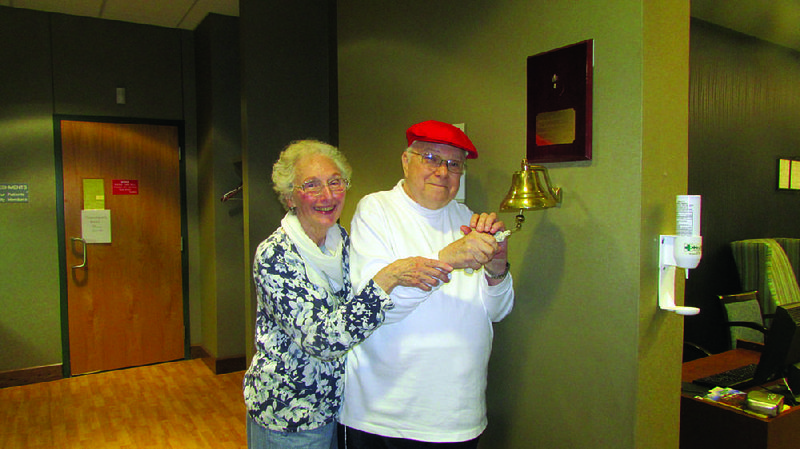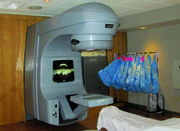The bad news came in four words: "You have prostate cancer."
About 2,000 Arkansas men are diagnosed with prostate cancer each year, but the news hit me like the proverbial ton of bricks. One minute I didn't have cancer and the next minute I did.
But some good news emerged as I asked questions. Prostate cancer is treatable and curable, especially when caught early.
On Sept. 29, 2016, I learned from a TV noon news show that the North Little Rock location of Arkansas Urology was offering free prostate screenings that evening, for the annual Prostate Cancer Awareness Month. I went, as I had several times before. The location was convenient because I live in North Little Rock.
Dozens of men were lined up, but the wait wasn't long. After some paperwork, I waited until called to have my blood drawn. It was painless, although I couldn't look. I hate needles.
The test would measure how much PSA (prostate-specific antigen) was in my blood. PSA is a protein produced by the prostate gland, and it is normal to have tiny amounts in your blood. Older men normally have more than younger men; but extra-high PSA is a red flag.
Next I went into a small room for a digital (finger) rectal exam. I do not need to describe that. The doctor said he felt a small nodule on my prostate, but that I shouldn't be concerned until my PSA score came back.
A week later, Oct. 7, I received a form letter that said my PSA was 4.4, and that it was "abnormal," as was my digital exam. I was advised to make an appointment with a urologist.
Later I found out that a PSA over 4.0 indicated the probable presence of cancer. I also learned that there is some controversy about PSA numbers, but doctors say everyone should be tested anyway. Because that's confusing, men should talk to one or more doctors and educate themselves -- read respectable internet sites and brochures and listen to men who have been through the process.
I'm one of those men. That's why I'm telling my story.
I called the urology clinic for an appointment -- the earliest they could see me was a month later.
At that meeting I learned about treatment options and was advised to have a biopsy of my prostate. I decided to get a second opinion.
In January, I met with another urologist, Dr. Ronald Kuhn, with my wife this time. I advise taking your wife or another family member to every appointment. Cancer discussions are hard to manage alone. I was glad for Jan's support.
The bottom line from that meeting was: How to proceed was still my choice, and I had options.
Some medical people say that at my age (80) I likely will die from something other than usually slow-growing prostate cancer. On the other hand, did I want to live (however long) knowing something was growing inside me, and if cancer, didn't I want to fight it?
So I agreed to a biopsy, and it was scheduled at the urology office Feb. 6.
I arrived at 7:30 a.m., undressed and put on one of those drafty, open-back gowns. At least a nurse brought me a warm blanket.
I was sedated and the biopsy began (I'm told, since I was out). A small ultrasound probe was inserted in my rectum, through which a biopsy needle gathered tiny samples from several places on my prostate. Waking up, I was surprised it was over. It actually took only about 15 minutes.
The dreaded call came from a nurse Feb. 14, of all days: My biopsy was positive. I had cancer.
We scheduled a CT and a full body scan to determine if the cancer had spread. Those happened Feb. 23.
Four days after that, Feb. 27, I had a follow-up with Kuhn. The good news was the cancer had not spread beyond my prostate.
Regarding the biopsy, out of 14 core samples taken, five indicated cancer. Three registered a Gleason score of 6, indicating low or intermediate grade cancer; while two registered 7, or moderately aggressive cancer. Named for the pathologist who developed the scoring system in the 1960s, Gleason scoring systems predict how quickly cancer will grow.
Kuhn sent my biopsy samples to a genetics lab, and March 31, I received a call saying the genetics lab confirmed my cancer was aggressive. I made another appointment.
The doctor explained my options:
• Do nothing, taking a wait-and-see approach;
• Surgery to remove the prostate;
• Radiation; and
• Hormone therapy. Hormone shots kill off the male hormone testosterone, which is what prostate cancer feeds on. Possible side effects might be hot flashes. My wife said, "Welcome to my world."
Because of my Gleason scores, Kuhn recommended a combination radiation and hormone treatment. I said I would think about it.
SUPPORT GROUP
Arkansas Urology hosts a Men's Support Group on the first Tuesday of every month, so I went to the April 3 meeting. I was one of three first-timers. I listened; I asked questions. I learned a number of things I'm glad I learned.
I did more research on the internet and talked with my family doctor. He said to go with what my urologist recommended.
So I told my urologist April 10 that I wanted to fight my cancer with radiation and hormone treatments. He set up an appointment with the Arkansas Prostate Cancer Center in Little Rock.
April 17, Jan went with me to meet Dr. Jack Wang (pronounced Wong) at the center. We learned what to expect from my 45 daily radiation treatments. I received a folder of information, including two informative booklets from the National Cancer Institute. We confirmed our decision to go ahead.
The next week I went back to Kuhn's office so he could insert fiducial markers (pins) in my prostate. These pins help line up the radiation beams. That procedure was much like my biopsy, so I was not awake.
May 8, I returned to the center for another CT scan, to see if the pins were in place, to tattoo small marks for the laser beams to zoom in on, and to pose for fabrication of a Vac-Loc, a molded form that is used during radiation to align the lower body on the table and to help keep the legs still.
WE BEGIN
May 16, I began my treatments. Fifteen minutes before each day's radiation, I was to drink 20 ounces of water, all at once. I had been given a bottle to use. Water fills the bladder so it lifts away from the prostate, minimizing the chance of radiation damage to it.
Since May 16 was a Tuesday, I saw Wang. He likes to see each patient on Tuesdays, to ask how things are going. Tuesday was also the day to weigh in, check my blood pressure and to answer questions about any changes in bodily functions, including any side effects.
I went into the treatment room, was asked my birthdate to ensure they had the right leg form, and lay down on a table (draped for sanitary reasons). I pulled my warmups down several inches, exposing my lower abdomen, under which lies the prostate. I was amused that one technician -- obviously Southern -- always said, "Pull down your britches."
Patients feel the need to do something with their arms and hands and so are asked to fold their arms, clasp their fingers or grip both sides of a six-inch rubber ring. Then we are asked to remain as still as possible for eight minutes or so while the machine rotates back and forth.
What to do while you lie there? You can keep your eyes open (without moving your head) and watch the laser machine go through its sequence of rotations. Or close your eyes and think of whatever is on your mind.
Music is piped in directly overhead, which helped pass the time as well as calm my anxiety. But at first it was hard rock. After two treatments, I asked if I had a choice of genres and was told I did. So I chose what my children (and the technicians) call "elevator music" -- soothing instrumentals.
Later I was told by a technician that after I left they had to change my music because it made them sleepy.
This went on for 45 days. We got a four-day break for the July Fourth weekend, and I skipped one day to attend a convention. But otherwise it was the same, day after day, week after week.
WE ARE NOT ALONE
During my two months of treatments -- May 16 to July 21 -- I met men from Pine Bluff, Mountain Home, Cabot, Morrilton, Hot Springs and elsewhere. Most drove in for their treatment and then drove home. Others came from and returned to work. Some came with their spouses; most came alone.
Jan drove me most of the time -- 17 miles one way -- which made drinking all that water en route easier.
The last day, I got hugs from all the staff, a certificate of completion and a packet of instructions with follow-up appointments.
And I got to ring a bell in the lobby as a reward for completing the 45 days. It felt good. Jan rang with me.
Every staff member I had encountered treated me well, making the entire process almost pleasant. Perhaps they were so friendly because I did magic tricks and gags (including giving each one a red nose on Red Nose Day, May 25).
So what next? I was told I had to wait three months before my next PSA test, for the radiation to work its way out of my body. When I went in for my monthly hormone-killing shot on Sept. 12, I expressed my frustration about having to wait so long. The woman I know as "Nurse Caroline" told me I could have another PSA test any time, even that day.
I said, "Then let's do it."
I was surprised she called with results so quickly -- the next afternoon -- and I wasn't prepared. She had just received my result and wanted to tell me. She said it was zero-point-zero-one.
I asked her to repeat that, not sure I had heard right.
She said the same thing: 0.01. I was speechless. I didn't even ask her what that meant. She offered to mail me the report and I said OK.
I sat there for a few moments, stunned, then got up to tell my wife. When she saw my face, she knew something important had happened. But by that time the emotion had caught up with me, and I broke down.
She hugged me as I shook and cried. Finally I got out my good news. Jan said, "It's nice when they are tears of joy."
So that's my story. I urge all men age 50 and older to get their prostate checked (40 for men with a family history of prostate cancer and for black men, who are at higher risk). Your family doctor can do it.
Finally, I suggest we all look up the Arkansas Prostate Cancer Foundation website and use its resources, including the list of screening events: arprostatecancer.org.
ActiveStyle on 11/27/2017


